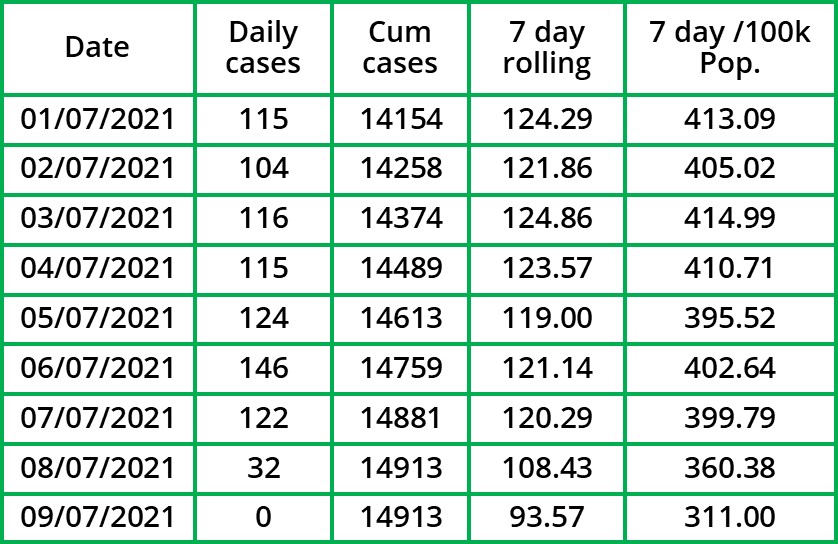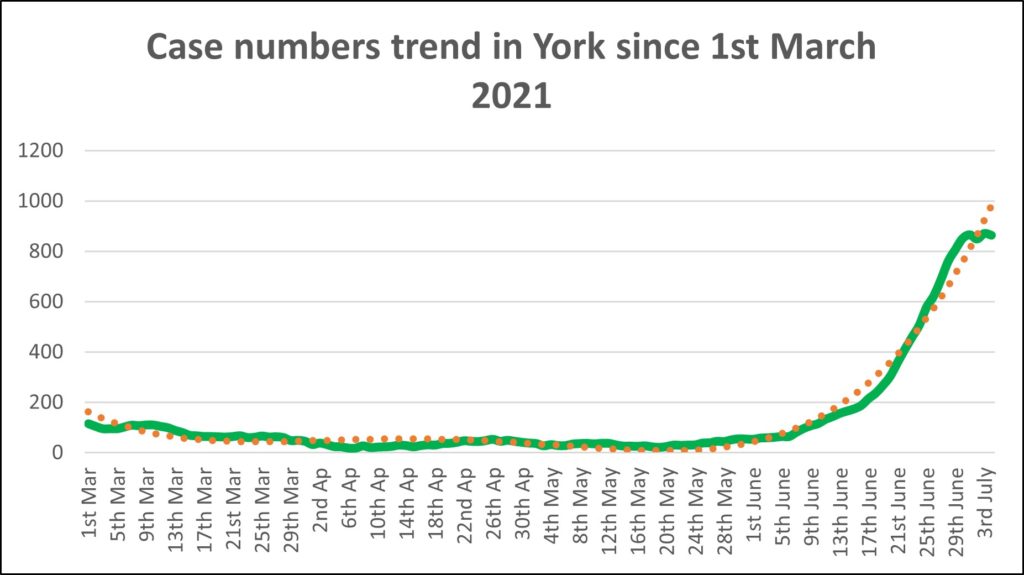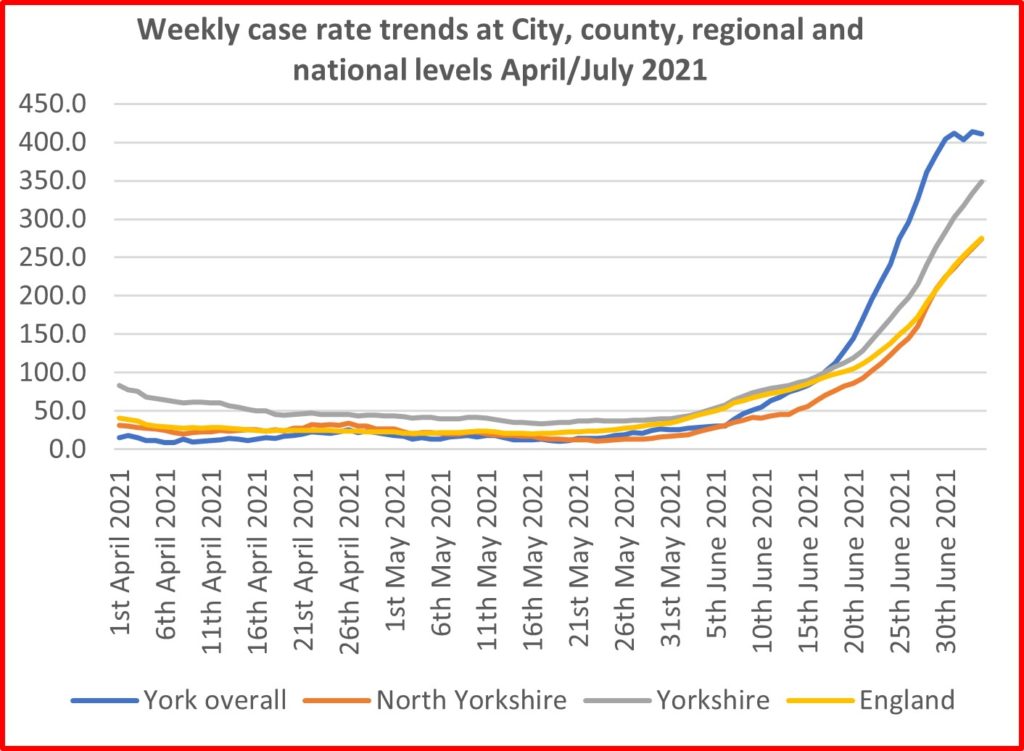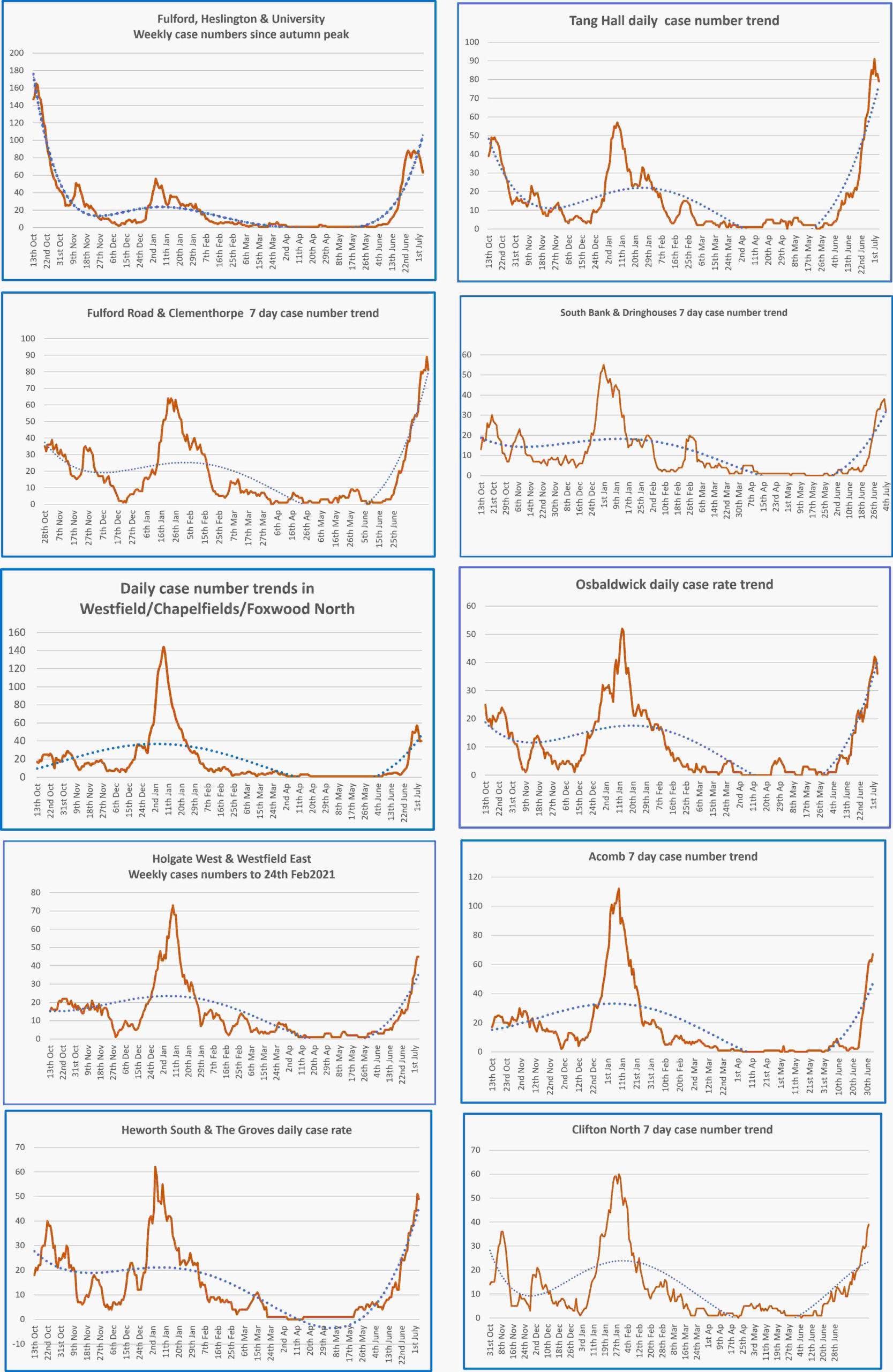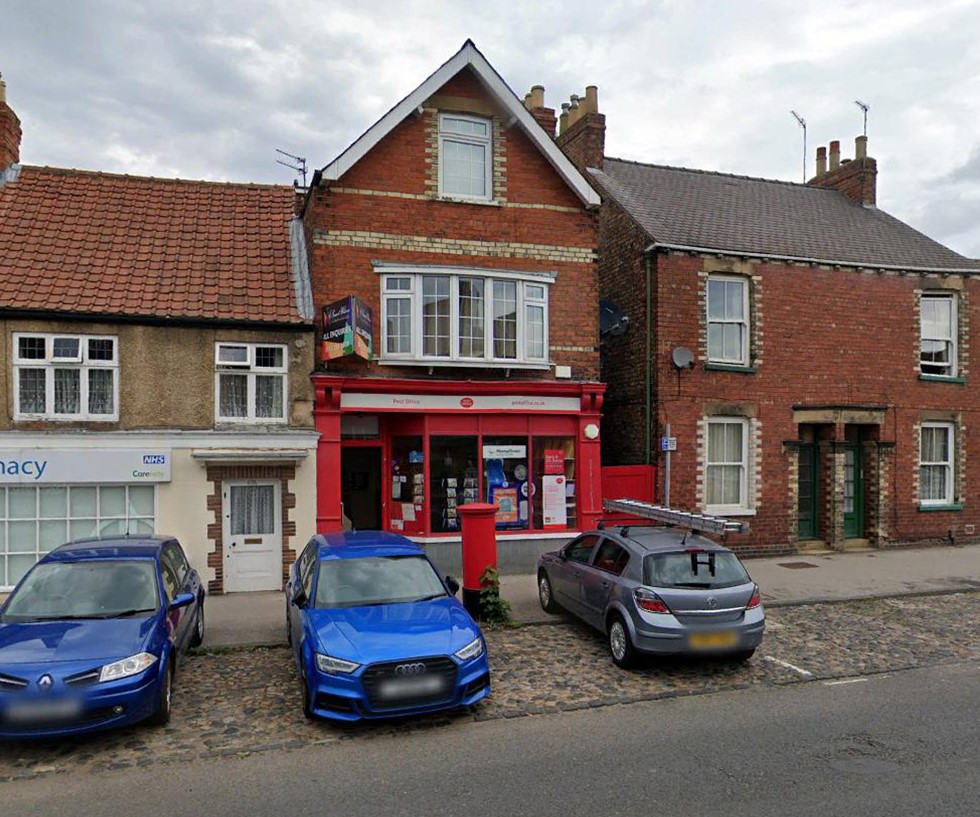Hospital patients and deaths
One additional hospital patient reported today
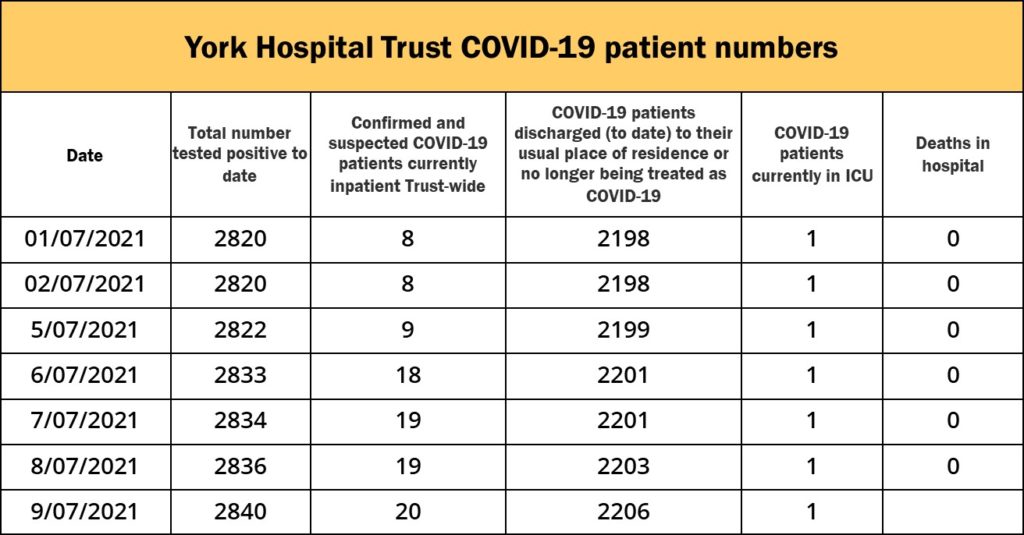
Test results
128 positive test results today, Brings the cumulative total up to 14,913.
The number of cases in the City has reduced from 872 to 865
The rate /100k population falls to 410.71. The rate is on course to stablise at around 400 over the next few days.
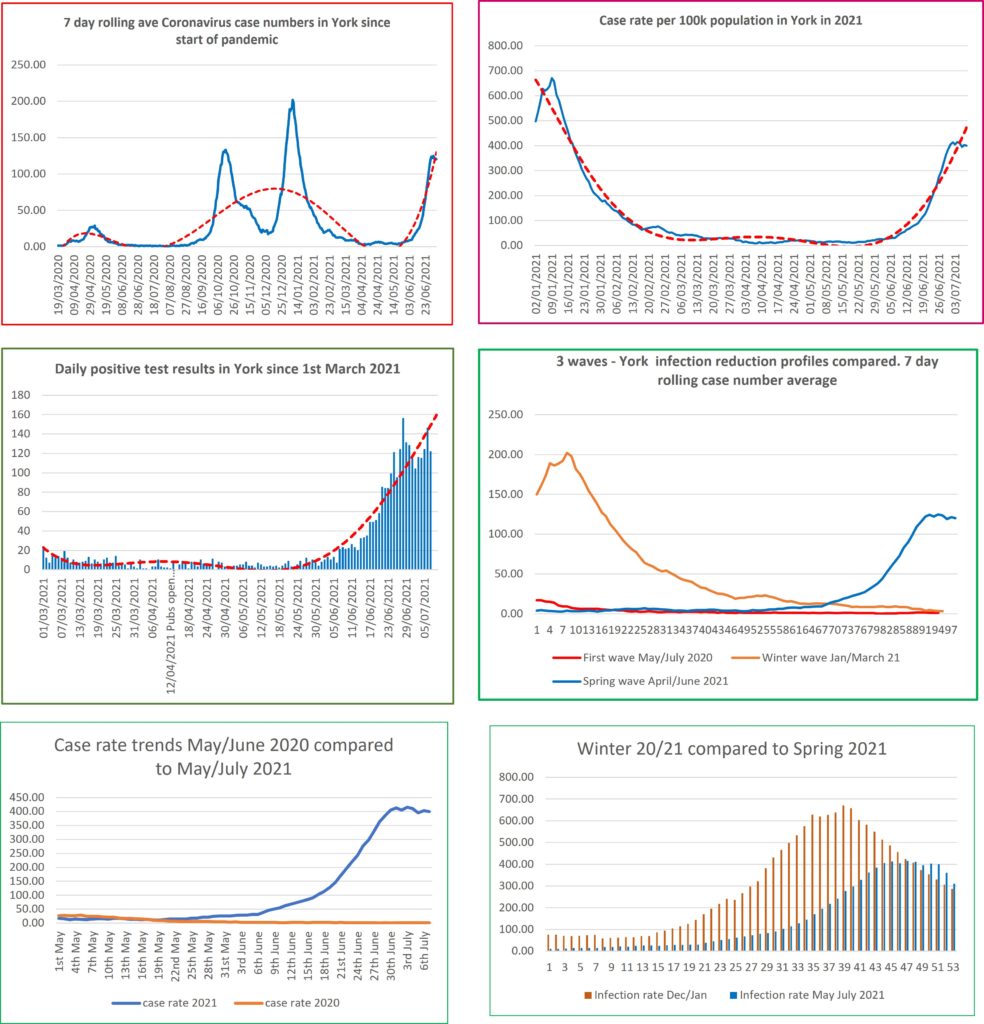
Some of the slides used at a Council meeting which took place on Wednesday have now been published, They include some interesting information about the spread of infections. The following graph confirms that the majority of cases are connected with groups still in education.

Neighbourhoods
Infection rates continue to fall at Heslington/University. It no longer has the highest rate in the City. The highest infection rate can now be found in Tang Hall
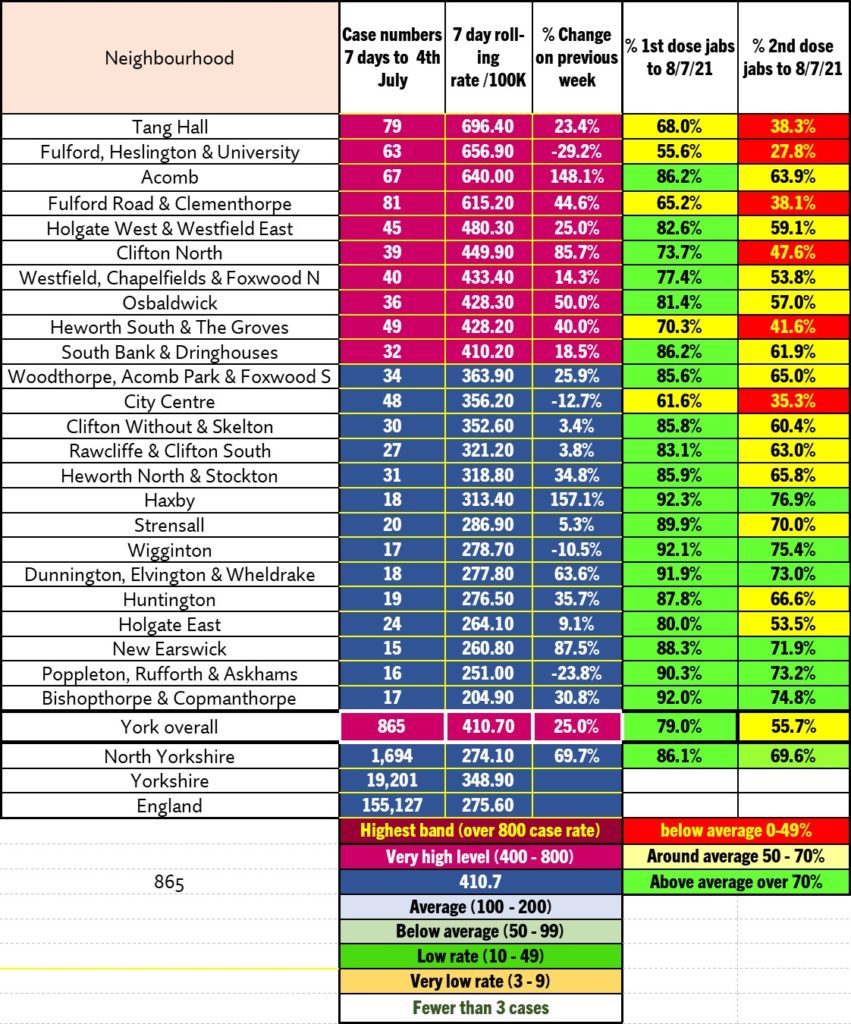
Both Tang Hall and Fulford Road/Clementhorpe are now experiencing the highest number of COVID cases recorded since the pandemic began in early 2020
The Council have published information on how vaccination levels vary for different age groups/occupations
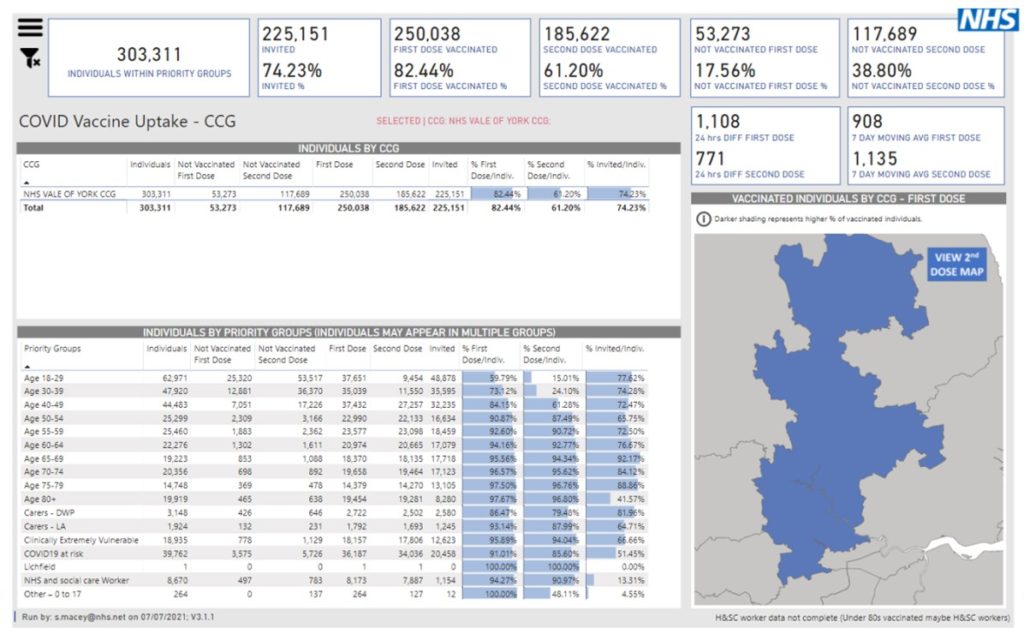
Figures released on Wednesday suggest that there is some SPARE CAPACITY in the vaccination programme
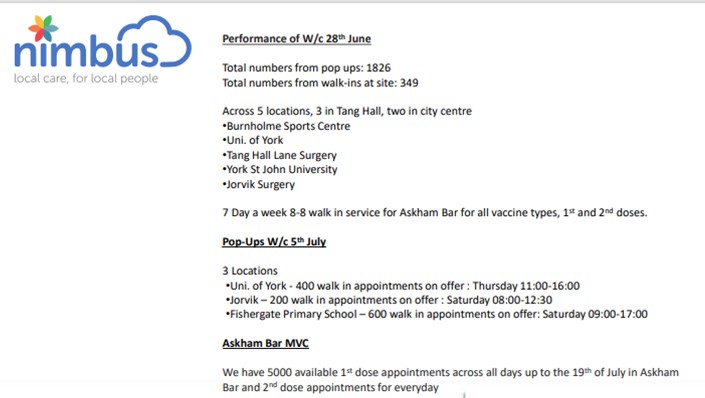
Vaccinations
1296 vaccinations were completed yesterday (Thursday)

Tests
- 8235 PCR tests were completed during the week ending 4th July 2021
- Of these, 10.3% were positive. That represents a reduction on the 10.5% positivity found during the previous period.
- 2669 “lateral flow” tests were also completed on 8th July 2021
Council commentary updates
The data is accurate as at 8.00 a.m. on Friday 09.07.21. Some narrative for the data covering the latest period is provided here below:
People with Covid Symptoms
• NHS Pathways/111 triages – as at 6.7.21 there had been 71 total covid telephony triages in the CYC area in the last 7 days. The peak number of triages was 192 in the 7 day period to 22.9.20.
• As at 8.7.21, the Covid Symptom App estimates 723 per 100,000 in York with symptomatic covid (responses from a sample of 3,807 people). The peak rate was 1,283 on 7.1.21.
Diagnosed cases
• As at 8.7.21 York has had 14,785 cases since the start of the pandemic, a rate of 7,020 per 100,000 of population. The cumulative rate in York is below the national (7,750) and regional (8,291) averages.
• The PHE ‘Exceedance’ rating compares the no. of new cases over a 14 day period with the previous 6 weeks and provides a RAG rating to indicate if the previously observed trend in the number of new cases is worsening. The latest rating for York (5.7.21) is Red.
• The provisional rate of new Covid cases per 100,000 of population for the period 30.6.21 to 6.7.21 in York is 398.4 (839 cases). (Using data published on Gov.uk on 8.7.21).
• The latest official “validated” rate of new Covid cases per 100,000 of population for the period 27.6.21 to 3.7.21 in York was 414 (872 cases). The national and regional averages at this date were 263.9 and 333.2 respectively (using data published on Gov.uk on 8.7.21).
• York is currently ranked 119th out of 149 Upper Tier Local Authorities (UTLAs) in England with a rank of 1 indicating the lowest 7 day rate.
• For the 7 day period 26.6.21.to 2.7.21, the number of cases in each ward varied from 3 to141 and rates varied from 72.3 to 929.7 per 100,000.
• The rate of new Covid cases per 100,000 of population for the period 27.6.21 to 3.7.21 for people aged 60+ in York was 62.5 (31 cases). The national and regional averages were 47.3 and 56.3 respectively.
• As at 6.7.21, the latest 7 day positivity rate in York (Pillar 2 PCR tests only) was 13.67%. The national and regional averages are 10.2% and 13.5% respectively.
• As at 6.7.21 the latest 7 day positivity rate in York (Pillar 2 Lateral Flow Tests only) was 1.27%. The national and regional averages are 1.0% and 1.4% respectively.
• As at 6.7.21 the latest 7 day positivity rate in York (Pillar 1 tests only) was 1.0%. The national average is 1.1%.
• As at 2.7.21 York University reported 240 individuals within the University community who were currently self-isolating because they have had a positive COVID-19 test. The peak number was 331 on the 19.10.20.
• As at 28.6.21 York St. John reported 4 individuals within the University community who were currently self-isolating because they have had a positive COVID-19 test. The peak number was 82 on the 8.10.20.
Contact Tracing
• Local Contact Tracing. Between 10.3.21 and 2.7.21, 1,239 referrals had been actioned by the local contact tracing service. Of the referrals actioned, 1,158 (93.5%) were successful and 81 (6.5%) were unable to be reached via phone or home visit, but guidance leaflets were posted where possible. (NB on the 10.3.21 the local CYC team became responsible for contacting all cases rather than just those that the national team could not contact).
Cases in Residential Care Settings
• As at 7.7.21 there were 3 care homes in the CYC area with confirmed Covid-19 infection (at least 1 case of either a staff member or resident).
• The latest ‘outbreak’ (2+ cases of either a staff member or resident) in a residential care setting in York were reported by PHE on 2.7.21 (1 home).
Cases amongst School Aged Children
• In the 7 days up to 5.7.21 there were 107 children of primary or secondary school age who tested positive (across 34 different schools).
COVID Bed Occupancy in York Hospital
• As at 7.7.21 there were 15 confirmed Covid-19 patients in General/Acute beds. The previous figure was 5 on 29.6.21. The peak number was 157 on 19.1.21.
• As at 7.7.21 there was 1 confirmed Covid-19 patient and 0 suspected Covid-19 patients in the Intensive Treatment Unit. The previous figures were 1 and 0 on 29.6.21. The peak number for people in ITU was 19 on 10.5.20.
R Number
• The ‘R’ value (the number of people that one infected person will pass on a virus to, on average) for the North East and Yorkshire area on 2.7.21 was estimated to be in the range 1.2 to 1.4. The previous estimate was (1.2 to 1.5) on 25.6.21.
Variants of Concern
• In the latest month for which data is available, 816 cases in York (with a specimen date between 5th June 2021 and 4th July 2021) had been processed in a laboratory which is able to carry out the required sequencing in order to identify Variants of Concern (VOC) or Variants under Investigation (VUI). Of these, there had been 802 cases (genomically confirmed or provisional genotyping) of the Delta Variant of Concern (VOC-21APR-02) which was first identified in India.
Total Vaccinations
• As at 7.7.21 a total of 143,963 CYC residents have had the first dose of the vaccine. This represents 82.5% of the estimated adult (18+) population of York.
• As at 7.7.21 a total of 100,904 CYC residents have had both doses of the vaccine. This represents 57.9% of the estimated adult (18+) population of York.
• Source: PHE Covid-19 Situational Awareness Explorer
Deaths
The two sources about deaths from Covid-19 at LA level are ONS data and local registrar data. They are derived from the same source (civil registration data). ONS data is more comprehensive as it includes deaths of York residents which have occurred and been registered outside York. Local registrar data provides a breakdown by age and gender. For both data sources a death from Covid-19 is said to have occurred when Covid-19 has been recorded on the death certificate. The most recently available data is summarised below:
• ONS Weekly data: In the most recent period (Week 25: 19.6.21 to 25.6.21) 0 Covid-19 deaths were recorded as having occurred for CYC residents. There has been one recorded covid death between week 18 and week 25.
• ONS Cumulative data: Since the start of the pandemic, for deaths occurring up to 18th June 2021 and registered up to 26th June 2021, 397 Covid-19 deaths were recorded as having occurred for CYC residents (228 in hospital, 136 in care homes, 25 at home/elsewhere and 8 in a hospice). The number of deaths per 100,000 of population in York is 188.49 which is lower than the national average of 232.76
• Age / Gender breakdown (using registrar data): The average age of the CYC residents who died was 82.1, with an age range of 44-104. The age profile of the CYC residents who have died is older than the national average (79.6% were aged 75+ compared with 72.9% nationally). 47.7% of the CYC residents who died were male. The national average is 54.4%.

